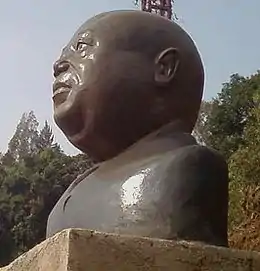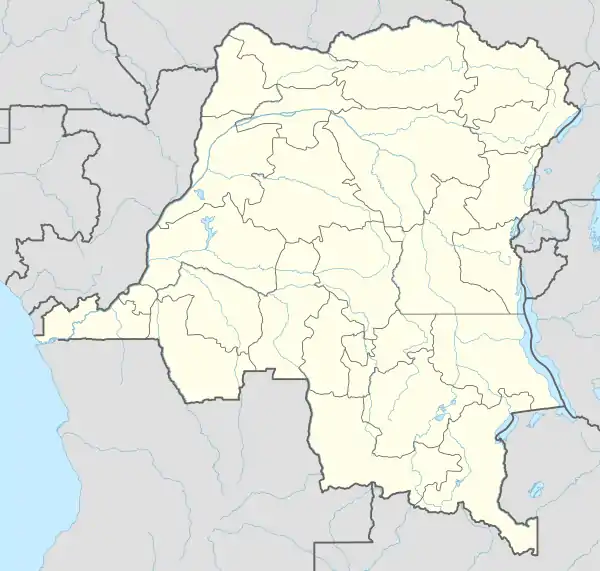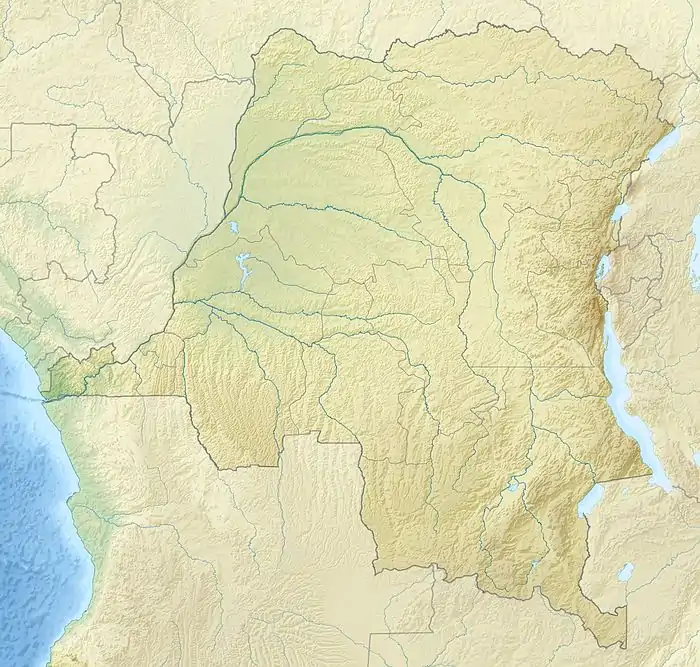Assassination of Laurent-Désiré Kabila
Congolese President Laurent-Désiré Kabila was assassinated on 16 January 2001 in his office at the Marble Palace, Kinshasa, his official residence. The assassin who killed him is still unknown, but evidence traces to an 18 year old boy named Rashidi Kasereka, who was later shot dead. The real assassin fled Kinshasa and crossed the river into the Republic of the Congo. The most information that the government has is that some kadogos were part of this plan.
| Assassination of Laurent-Désiré Kabila | |
|---|---|
 A bust of Laurent-Désiré Kabila. | |
| Location | Palais de Marbre, Kinshasa, The Democratic Republic of the Congo. |
| Coordinates | 4.3639°S 15.2506°E |
| Date | 19 January 2001 |
Attack type | Assassination |
| Victim | Laurent-Desire Kabila |
Reputation
Kabila's reputation had caught up to him as he killed more and more kadogos. The day before his assassination, Kabila had seen the execution of 47 kadogos which he believed had a plot to kill him. Due to this, his reputation with the army had plummeted and Kabila's life threat was in danger. The kadogos were being killed off more and more as Kabila's life was in more danger.[1]
In November 2000, Kabila had thought that he had discovered a plot against him and had arrested, tormented, and killed soldiers loyal to Commandant Anselme Masasu Nindaga who had days earlier made a speech at a reunion for 1,200 kadogos in Kinshasa.[2] The plot to assassinate Kabila started in early January 2001 when a group of kadogos went to Brazzaville and drew up a plan which followed the plan of Operation Mbongo Zero.[1]
Operation Mbongo Zero
Operation Mbongo Zero was the plane that was drew up by the conspirators that explains how the conspirators would penetrate key positions at the capital, which included the Marble Palace. Mbongo means "bull" in Swahili. After they would access the palace, the penetrators would the approach the president with a revolver and fire at him. This group of penetrators were kadogos who fought with Kabila against Mobutu Sese Seko's military dictatorship. Kasereka reported to had said “I will kill him,”[3]


Attack
On January 16, 2001, the assassin had entered the president's office as Kabila was discussing with an economics adviser, Emile Mota[4], about a looming summit with France he hoped would protect his presidency over the Congo. The assassin bent over Kabila, and the president leaned towards him. The kadogo then pulled out a revolver and shot the president four times, and then escaped the palace with other penetrators while the palace was filled with gunfire.[1]
Mwenze Kongolo had been waiting for admission to the palace at 1:45 PM and heard gunshots being fired in the building.[4] Inside, other bodyguards rushed in the room and fired at the assassin, who was hit first in the leg, then twice more.[4] After 15 minutes, Kabila was in a in a helicopter headed to to a clinic in Gombe, Kinshasa. Curfew that day started at 6, and after 8 hours, there was a motorcade set off from the clinic for the long drive to N'djili Airport, with an ambulance in the middle.[4]
Kabila was transported to Harare, Zimbabwe for medical treatment.
Aftermath
After his father's death, Joseph Kabila succeeded his father at the young age of 29 due to the statement that if he [Laurent] were to die in office, that Joseph would take over. [5]The government also kept control although Kabila is dead. Kabila had a state funeral on the 20, when he was flown to Baudouinville, his home village, then to Lubumbashi, then back to Kinshasa.[5] He was buried somewhere in Kinshasa, it is unknown specifically.
After the assassination, a group of kadogos were eventually arrested and admitted to be part of the operation.[3] The reason behind the attack was revealed, the reason is revenge after Kabila betrayed them after meeting with one of the kadogo's longtime enemy, Paul Kagame.[1] According to the Justice Minister Mwenze Kongolo, the killer was Rashidi Kasereka, who was shot later while escaping the palace.[1]
It has also been assumed that a bodyguard had shot Kabila.[6]An investigation found 135 people where accused of the killing of Kabila, including 4 children.[7] No one was found to be the killer of Kabila. The RFI had let out a m message on the radio of Kabila's death. The killer is still alive and in the Brazzaville-Kinshasa area. 26 people, including Kabila's own cousin, Colonel Eddy Kapend, were sentenced to death. 45 were proclaimed innocent and exonerated. 64 defendants were jailed.[7]
19 years later, on January 8, 2021, President Félix Tshisekedi had pardoned 28 of the convicted inmates who served their sentences in 2005, from the Makala Prison in Kinshasa.[8] The countries involved have been speculated to be Rwanda which had been rivals with the Congo for a long period of time, and Angola.
References
- Staff, Guardian (2001-02-11). "Revealed: how Africa's dictator died at the hands of his boy soldiers". the Guardian. Retrieved 2021-02-04.
- "Rights group accuses Kinshasa of "executions"". The New Humanitarian (in French). 2000-12-18. Retrieved 2021-02-05.
- Stearns, Jason (2010-08-03). "What you didn't know about Congolese history: The Killing of LDK". Congo Siasa. Retrieved 2021-02-04.
- Vick, Karl (2001-01-27). "Congo'sStrangelySmoothTransition". Washington Post. ISSN 0190-8286. Retrieved 2021-02-04.
- Onishi, Norimitsu (2001-01-27). "Glimpse of New President as Joseph Kabila Takes Oath in Congo (Published 2001)". The New York Times. ISSN 0362-4331. Retrieved 2021-02-04.
- AfricaNews (2021-01-16). "DR Congo: 20th anniversary of Laurent Désiré Kabila's assassination". Africanews. Retrieved 2021-02-04.
- "The Chronic: Who Killed Kabila | Heinrich Böll Stiftung | Cape Town. South Africa | Namibia | Zimbabwe". Heinrich-Böll-Stiftung. Retrieved 2021-02-04.
- "Tshisekedi pardons Laurent Kabila killers". The East African. Retrieved 2021-02-04.

